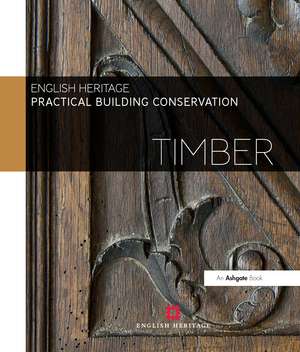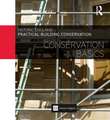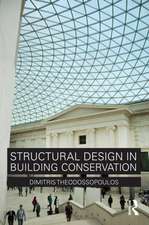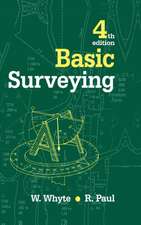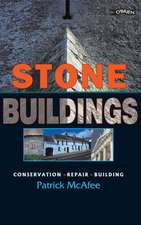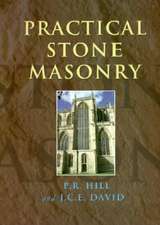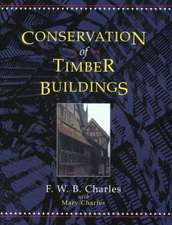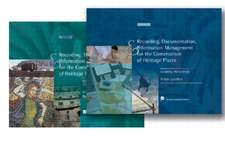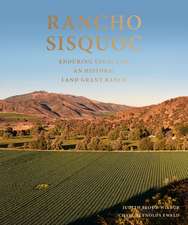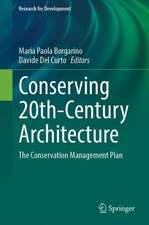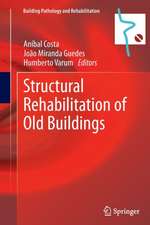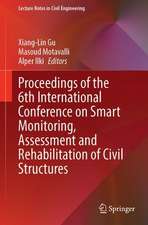Practical Building Conservation: Timber: Practical Building Conservation
Autor Historic Englanden Limba Engleză Hardback – 28 mar 2012
| Toate formatele și edițiile | Preț | Express |
|---|---|---|
| Paperback (1) | 280.57 lei 3-5 săpt. | +47.52 lei 4-10 zile |
| Taylor & Francis – 19 iul 2024 | 280.57 lei 3-5 săpt. | +47.52 lei 4-10 zile |
| Hardback (10) | 942.51 lei 3-5 săpt. | +48.14 lei 4-10 zile |
| Taylor & Francis – 24 apr 2013 | 942.51 lei 3-5 săpt. | +48.14 lei 4-10 zile |
| Taylor & Francis – 28 mar 2012 | 943.03 lei 3-5 săpt. | +50.00 lei 4-10 zile |
| Taylor & Francis – 28 mar 2012 | 947.37 lei 3-5 săpt. | +65.84 lei 4-10 zile |
| Taylor & Francis – 28 mar 2012 | 947.37 lei 3-5 săpt. | +65.84 lei 4-10 zile |
| Taylor & Francis – 24 apr 2013 | 1010.51 lei 3-5 săpt. | +46.01 lei 4-10 zile |
| Taylor & Francis Ltd. – 28 mar 2012 | 1015.30 lei 3-5 săpt. | +63.47 lei 4-10 zile |
| Taylor & Francis – 2 ian 2014 | 1016.97 lei 3-5 săpt. | +69.56 lei 4-10 zile |
| Taylor & Francis – 28 mar 2012 | 1020.54 lei 3-5 săpt. | +82.53 lei 4-10 zile |
| Taylor & Francis – 28 oct 2014 | 1020.74 lei 3-5 săpt. | +83.30 lei 4-10 zile |
| Taylor & Francis – 28 noi 2015 | 1067.58 lei 3-5 săpt. | +128.97 lei 4-10 zile |
Preț: 947.37 lei
Preț vechi: 1041.06 lei
-9% Nou
Puncte Express: 1421
Preț estimativ în valută:
181.34€ • 197.04$ • 152.42£
181.34€ • 197.04$ • 152.42£
Carte disponibilă
Livrare economică 31 martie-14 aprilie
Livrare express 14-20 martie pentru 75.83 lei
Preluare comenzi: 021 569.72.76
Specificații
ISBN-13: 9780754645542
ISBN-10: 0754645541
Pagini: 498
Ilustrații: Includes 515 colour and 31 b&w illustrations
Dimensiuni: 220 x 240 x 34 mm
Greutate: 1.75 kg
Ediția:New ed
Editura: Taylor & Francis
Colecția Routledge
Seria Practical Building Conservation
Locul publicării:Oxford, United Kingdom
ISBN-10: 0754645541
Pagini: 498
Ilustrații: Includes 515 colour and 31 b&w illustrations
Dimensiuni: 220 x 240 x 34 mm
Greutate: 1.75 kg
Ediția:New ed
Editura: Taylor & Francis
Colecția Routledge
Seria Practical Building Conservation
Locul publicării:Oxford, United Kingdom
Public țintă
Professional Practice & DevelopmentCuprins
About this book. Using these books. Part 1 1. Materials and History of Use 2. Wood: Biology and Properties 3. Conversion and Seasoning 4. Water and Dimensional Stability 5. Traditional Tools and Working Methods Part 2 6. Deterioration and Damage: Insects and Fungi 7. Environmental Problems 8. Other Causes of Deterioration Part 3 9. Assessment: Understanding Buildings and Their Condition 10. Structural Timbers 11. Non-Structural Timbers (joinery) 12. Fixings and Hardware 13. Specialist Investigations Part 4 14. Repair and Treatment 15. Introduction 16. Timber-Frame Structures 17. Preservative Pre-Treatments' Adhesives, Fillers and Fastenings 18. Insect Infestation and Fungal Decay 19. Upgrading Historic Buildings to Meet Modern Standards Part 5 20. Care and Maintenance: Continuing Care Conclusions. Glossary. Index
Notă biografică
The contents reflect the work of the Building Conservation and Research Team, their colleagues at Historic England, and their consultants and researchers, who together have many decades of accumulated experience in dealing with deteriorating building materials and systems of all types. This multi-disciplinary team of architects, surveyors, conservators and scientists are responsible for standard setting and research across a wide range of Historic England activities. The team specialises in dealing with the practical, technical and scientific aspects of building materials decay and their treatment. The aim has been to provide practical advice by advocating a common approach of firstly understanding the material or building element and why it is deteriorating, and then dealing with the causes. The books concentrate on those aspects which are significant in conservation terms, and reflect the requests for information received by Historic England.
Recenzii
'[The Practical Building Conservation volumes] offer considerable information and advice on many aspects of conservation. Great emphasis is placed in all the volumes on making the reader familiar with the material in question, giving them as much information and direction as possible to allow them to understand what they are dealing with. It gives a comprehensive 'hands on' approach; solutions are found, methods described and practical tips freely given. It should be kept on the bookshelf within reach of most practising professionals in the field. ' - Jane Jones-Warner RIBA SCA AABC IHBC, Member RIBA Conservation Group
'A thoroughly comprehensive book, packed full of valuable information backed up by excellent drawings and illustrations.' - Cornerstone
'My overriding impression of this series is that it is comprehensive, well set out and easy to follow, and it should be of interest both to all involved in the repair and maintenance of historic buildings, and to the casual reader. Each volume stands alone or as part of a set. This represents a substantial body of work in the field of building conservation that is unlikely to be repeated in the near future. The tables and technical drawings are clear, and some of the photographs included are remarkable. The amount of information within each volume is staggering and must represent the nearest thing to a one-stop-shop for historic building practitioners.' - Context
'I found the content of the book to be both interesting and very informative. It certainly made me wonder just how much we have wasted, in particular, through replacement of windows where simple professional repair would have been both more cost effective and would have retained the original features. It also made me think just how much money we waste on treatment of timber when if property surveys are carried out by the right people the solutions can end up far more cost effective and less destructive to the building fabric.' - Building Engineer
'The primary editors for each volume acknowledge the contributions of numerous authors and the series' strength is in the breadth of the conservation community engaged in the project - a twenty-first-century galaxy of highly regarded practitioners and conservators brought together in a single technical series; the books are accessibly organized and elegantly designed. It is easy to navigate around them and, importantly, between them. Links to other volumes in the series are colour-coded in the text so that cross-referral to Stone, for example, from Mortars, which is frequently relevant, provides helpful signposting to the relevant detailed guidance in the companion handbook. The illustrations are enormously valuable and the Timber volume, in particular, includes axonometric drawings of timber structures that beautifully display complex construction. These volumes are in all ways an essential, one-stop resource for conservation practitioners: well-organized, expertly informed, compellingly illustrated, signposting other key resources and (let us not take this for granted) written in lucid English.' - The Historic Environment
'A thoroughly comprehensive book, packed full of valuable information backed up by excellent drawings and illustrations.' - Cornerstone
'My overriding impression of this series is that it is comprehensive, well set out and easy to follow, and it should be of interest both to all involved in the repair and maintenance of historic buildings, and to the casual reader. Each volume stands alone or as part of a set. This represents a substantial body of work in the field of building conservation that is unlikely to be repeated in the near future. The tables and technical drawings are clear, and some of the photographs included are remarkable. The amount of information within each volume is staggering and must represent the nearest thing to a one-stop-shop for historic building practitioners.' - Context
'I found the content of the book to be both interesting and very informative. It certainly made me wonder just how much we have wasted, in particular, through replacement of windows where simple professional repair would have been both more cost effective and would have retained the original features. It also made me think just how much money we waste on treatment of timber when if property surveys are carried out by the right people the solutions can end up far more cost effective and less destructive to the building fabric.' - Building Engineer
'The primary editors for each volume acknowledge the contributions of numerous authors and the series' strength is in the breadth of the conservation community engaged in the project - a twenty-first-century galaxy of highly regarded practitioners and conservators brought together in a single technical series; the books are accessibly organized and elegantly designed. It is easy to navigate around them and, importantly, between them. Links to other volumes in the series are colour-coded in the text so that cross-referral to Stone, for example, from Mortars, which is frequently relevant, provides helpful signposting to the relevant detailed guidance in the companion handbook. The illustrations are enormously valuable and the Timber volume, in particular, includes axonometric drawings of timber structures that beautifully display complex construction. These volumes are in all ways an essential, one-stop resource for conservation practitioners: well-organized, expertly informed, compellingly illustrated, signposting other key resources and (let us not take this for granted) written in lucid English.' - The Historic Environment
Descriere
Timber deals with wide-ranging use of the material in historic buildings, from vast structural timber-frames through to high-class joinery and simple fixings.
